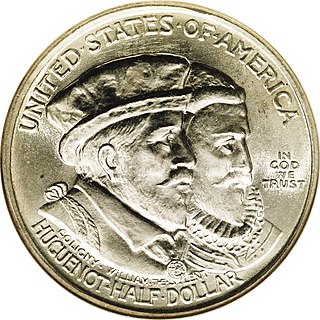The United States Mint has minted numerous commemorative coins to commemorate persons, places, events, and institutions since 1848. Many of these coins are not intended for general circulation, but are still legal tender. The mint also produces commemorative medals, which are similar to coins but do not have a face value, and therefore are not legal tender.

The Alabama Centennial half dollar, or Alabama half dollar, was a commemorative fifty-cent coin struck by the United States Bureau of the Mint in 1921 as a belated acknowledgement of the 100th anniversary of Alabama's admission to the Union in 1819. The coin was created by Laura Gardin Fraser, the first woman credited with designing a coin.

The Bridgeport, Connecticut, Centennial half dollar is a commemorative fifty-cent piece issued in 1936 by the United States Bureau of the Mint to honor the 100th anniversary of the incorporation of Bridgeport, Connecticut, as a city. Designed by Henry Kreis, the obverse depicts the showman P. T. Barnum, who was one of Bridgeport's most famous residents, was mayor of the city, helped develop it, and is buried there. The reverse depicts a stylized eagle.

The United States Sesquicentennial coin issue consisted of a commemorative half dollar and quarter eagle struck in 1926 at the Philadelphia Mint for the 150th anniversary of American independence. The obverse of the half dollar features portraits of the first president, George Washington, and the president in 1926, Calvin Coolidge, making it the only American coin to depict a president in his lifetime.

The Huguenot-Walloon half dollar or Huguenot-Walloon Tercentenary half dollar is a commemorative coin issued by the United States Bureau of the Mint in 1924. It marks the 300th anniversary of the voyage of the Nieuw Nederlandt which landed in the New York area in 1624. Many of the passengers were Huguenots from France or Walloons from what is now Belgium; they became early settlers of New York State and the surrounding area.

The Lexington–Concord Sesquicentennial half dollar, sometimes the Lexington–Concord half dollar or Patriot half dollar, is a commemorative fifty-cent piece struck by the United States Bureau of the Mint in 1925 in honor of the 150th anniversary of the Battles of Lexington and Concord, which began the American Revolutionary War. It was designed by Chester Beach and features Daniel Chester French's 1874 The Minute Man statue on the obverse.

The Norse-American medal was struck at the Philadelphia Mint in 1925, pursuant to an act of the United States Congress. It was issued for the 100th anniversary of the voyage of the ship Restauration, bringing early Norwegian immigrants to the United States.

The Pilgrim Tercentenary half dollar or Pilgrim half dollar was a commemorative fifty-cent coin struck by the United States Bureau of the Mint in 1920 and 1921 to mark the 300th anniversary (tercentenary) of the arrival of the Pilgrims in North America. It was designed by Cyrus E. Dallin.

The Fort Vancouver Centennial half dollar, sometimes called the Fort Vancouver half dollar, is a commemorative fifty-cent piece struck by the United States Bureau of the Mint in 1925. The coin was designed by Laura Gardin Fraser. Its obverse depicts John McLoughlin, who was in charge of Fort Vancouver from its construction in 1825 until 1846. From there, he effectively ruled the Oregon Country on behalf of the Hudson's Bay Company. The reverse shows an armed frontiersman standing in front of the fort.

The Maryland Tercentenary half dollar was a commemorative fifty-cent piece issued by the United States Bureau of the Mint in 1934. It depicts The Rt Hon. The 2nd Baron Baltimore on the obverse and the Coat of Arms of Maryland on the reverse.

The Rhode Island Tercentenary half dollar is a commemorative fifty-cent piece struck by the United States Bureau of the Mint in 1936. The coin was designed by John Howard Benson and Arthur Graham Carey. Its obverse depicts Roger Williams, founder of the Colony of Rhode Island and Providence Plantations. It was intended to honor the 300th anniversary of Providence, Rhode Island, although it bears no mention of the city.

The Wisconsin Territorial Centennial half dollar was a commemorative half dollar designed by David Parsons and Benjamin Hawkins and minted by the United States Bureau of the Mint in 1936. The obverse depicts a pick axe and lead ore, referring to the lead mining in early Wisconsin, while the reverse depicts a badger and the territorial seal.

The Long Island Tercentenary half dollar was a commemorative half dollar struck by the United States Bureau of the Mint in 1936. The obverse depicts a male Dutch settler and an Algonquian tribesman, and the reverse shows a Dutch sailing ship. It was designed by Howard Weinman, the son of Mercury dime designer Adolph A. Weinman.

The Lynchburg Sesquicentennial half dollar was a commemorative half dollar designed by Charles Keck and struck by the United States Bureau of the Mint in 1936, to celebrate the 150th anniversary of the 1786 incorporation of the independent city of Lynchburg, Virginia. The obverse of the coin depicts former Secretary of the Treasury and U.S. Senator Carter Glass, a native of Lynchburg. The reverse depicts a statue of the Goddess of Liberty, with Lynchburg sites behind her, including the Old Courthouse and the city's Confederate monument.

The Delaware Tercentenary half dollar is a commemorative fifty-cent piece struck by the United States Bureau of the Mint to commemorate the 300th anniversary of the first successful European settlement in Delaware. The obverse features the Swedish ship Kalmar Nyckel, which brought early settlers to Delaware, and the reverse depicts Old Swedes Church, claimed to be the oldest Protestant church in the United States still in use as a place of worship. While the coins are dated "1936" on the obverse and the reverse also has the dual date of "1638" and "1938", the coins were actually struck in 1937.

























































